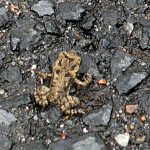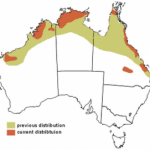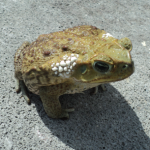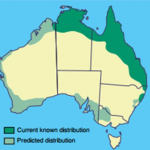Cane Toad
Cane toad is a large species of toad native to South and Central America. The species was originally used to eradicate pests from sugarcane and hence its name. The skin and parotoid glands behind the eyes are very toxic.
| Kingdom | Animalia |
| Phylum | Chordata |
| Class | Amphibia |
| Order | Anura |
| Family | Bufonidae |
| Genus | Rhinella |
| Scientific Name | Rhinella marina |
| Other Names | Giant neotropical toad, marine toad |
| Size | 10 to15 cm (3.9 – 5.9 in); largest recorded specimen measures 24 cm (9.4 in) |
| Weight | Largest recorded specimen weighs 1.3 kg |
| Color | Color ranges from gray, yellowish, red-brown, or olive-brown with different patterns; underside is cream-colored and may have shades of black or brown blotches |
| Distribution | South America, United States, and Central America (native); various islands of Oceania and the Caribbean, and Northern Australia (introduced) |
| Habitat | Subtropical forests, grassland, woodland, open clearings in urban areas |
| Diet | Beetles, ants, crickets, honey bees, bugs, winged termites, small rodents, birds, smaller toads |
| Predators | Caimans, snakes, fish |
| Breeding Season | Anytime of the year |
| Mode of Reproduction | Oviparous (egg laying) |
| Clutch Size | 8,000–25,000 eggs |
| Incubation Period | 1 to 3 days |
| Metamorphosis Period | 12 to 60 days |
| Reproductive Age | 1 to 2 years of age |
| Average Lifespan | In wild: 10 to 15 years in the wild In captivity: one specimen alive for 35 years |
| IUCN Conservation Status | Least Concern |
Cane Toad Pictures Gallery
- Baby Cane Toad
- Cane Toad Distribution Map
- Cane Toad Eggs
- Cane Toad Habitat
- Cane Toad Images
- Cane Toad Pet
- Cane Toad Photos
- Cane Toad Pictures
- Cane Toad Poison
- Cane Toad Spread Map
- Cane Toad Tadpole
- Cane Toad
- Cane Toads
- Giant Cane Toad
- Giant Neotropical Toad
- Images of Cane Toad
- Marine Toad
- Pics of Cane Toads
- Rhinella Marina
- The Cane Toad























